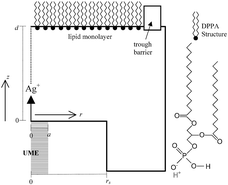Scanning electrochemical microscopy as a probe of Ag+ binding kinetics at Langmuir phospholipid monolayers
Abstract
A new method has been developed for measuring local

* Corresponding authors
a
Department of Chemistry, University of Warwick, Coventry, UK
E-mail:
p.r.unwin@warwick.ac.uk
b Department of Experimental Sciences, Universitat Jaume I of Castellón, Castellón, Spain
c Department of Inorganic and Analytical Chemistry, Hebrew University of Jerusalem, Jerusalem, Israel
d Department of Thermodynamics, Faculty of Physics, University of Valencia, Burjassot, Spain
A new method has been developed for measuring local

 Please wait while we load your content...
Something went wrong. Try again?
Please wait while we load your content...
Something went wrong. Try again?
D. P. Burt, J. Cervera, D. Mandler, J. V. Macpherson, J. A. Manzanares and P. R. Unwin, Phys. Chem. Chem. Phys., 2005, 7, 2955 DOI: 10.1039/B506611E
To request permission to reproduce material from this article, please go to the Copyright Clearance Center request page.
If you are an author contributing to an RSC publication, you do not need to request permission provided correct acknowledgement is given.
If you are the author of this article, you do not need to request permission to reproduce figures and diagrams provided correct acknowledgement is given. If you want to reproduce the whole article in a third-party publication (excluding your thesis/dissertation for which permission is not required) please go to the Copyright Clearance Center request page.
Read more about how to correctly acknowledge RSC content.
 Fetching data from CrossRef.
Fetching data from CrossRef.
This may take some time to load.
Loading related content
